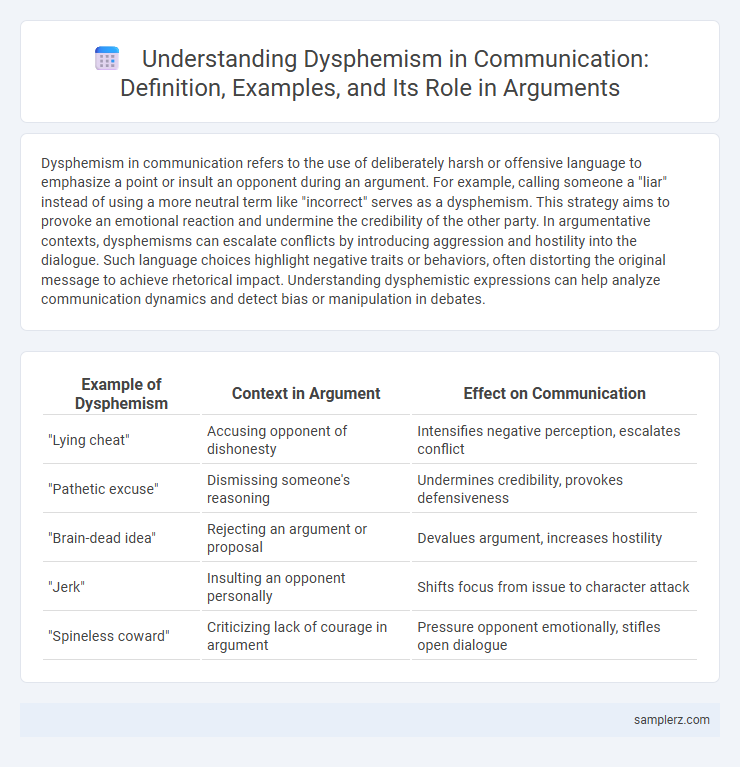Dysphemism in communication refers to the use of deliberately harsh or offensive language to emphasize a point or insult an opponent during an argument. For example, calling someone a "liar" instead of using a more neutral term like "incorrect" serves as a dysphemism. This strategy aims to provoke an emotional reaction and undermine the credibility of the other party. In argumentative contexts, dysphemisms can escalate conflicts by introducing aggression and hostility into the dialogue. Such language choices highlight negative traits or behaviors, often distorting the original message to achieve rhetorical impact. Understanding dysphemistic expressions can help analyze communication dynamics and detect bias or manipulation in debates.
Table of Comparison
| Example of Dysphemism | Context in Argument | Effect on Communication |
|---|---|---|
| "Lying cheat" | Accusing opponent of dishonesty | Intensifies negative perception, escalates conflict |
| "Pathetic excuse" | Dismissing someone's reasoning | Undermines credibility, provokes defensiveness |
| "Brain-dead idea" | Rejecting an argument or proposal | Devalues argument, increases hostility |
| "Jerk" | Insulting an opponent personally | Shifts focus from issue to character attack |
| "Spineless coward" | Criticizing lack of courage in argument | Pressure opponent emotionally, stifles open dialogue |
Understanding Dysphemism in Argumentative Communication
Dysphemism in argumentative communication involves using harsh or offensive language to create a negative impression of an opponent or their ideas, often intensifying conflict. For example, referring to a political opponent as a "liar" or "snake" serves to undermine their credibility and emotional appeal rather than focusing on logical reasoning. Recognizing dysphemism helps individuals critically evaluate arguments by distinguishing between emotional manipulation and substantive evidence.
Common Dysphemistic Strategies Used in Debates
Dysphemistic strategies in debates often involve name-calling, such as labeling opponents with derogatory terms like "liar" or "idiot" to undermine credibility. Another common tactic is using inflammatory metaphors, for instance describing an opponent's policy as a "disaster" or "nightmare" to evoke negative emotions. These strategies aim to provoke hostility and weaken the opponent's position rather than fostering constructive dialogue.
Impact of Dysphemism on Persuasive Discourse
Dysphemism in argument, such as labeling an opponent's policy as a "blundering disaster," intensifies emotional responses and undermines the opposing viewpoint's credibility. This harsh language can polarize audiences, making rational debate more difficult and often escalating conflicts. The impact on persuasive discourse is significant, as it shifts focus from constructive dialogue to emotional manipulation, potentially reducing the effectiveness of communication.
Political Arguments: Dysphemism in Action
In political arguments, dysphemism often manifests as derogatory labels such as "flip-flopper" to disparage opponents who shift policy positions, undermining their credibility. Terms like "propaganda machine" are used to criticize opposing parties' communication strategies, implying deliberate misinformation. This use of loaded language intensifies conflicts and polarizes public discourse by framing adversaries negatively.
Dysphemism Versus Euphemism: Contrasting Language in Arguments
In arguments, dysphemism manifests through the use of harsh or offensive terms like "liar" or "scammer" to attack opponents, deliberately invoking negative emotions and bias. Unlike euphemisms, which soften or obscure realities--for example, saying "passed away" instead of "died"--dysphemisms intensify conflict by emphasizing derogatory language. This contrast in communication strategies significantly influences the tone and persuasiveness of debates, often escalating hostility rather than fostering understanding.
Social Media Arguments: Modern Dysphemistic Trends
Social media arguments often showcase dysphemism through deliberate use of derogatory language, amplifying hostility and misunderstanding. Terms like "keyboard warrior" or "troll" are frequently deployed to demean opponents rather than engage in constructive debate. This trend exacerbates polarization, diminishing the quality of online communication and fostering toxic environments.
Dysphemism and Emotional Manipulation in Communication
Dysphemism in communication involves using deliberately harsh or offensive language to provoke negative emotions and manipulate an audience's perception during arguments. This tactic undermines rational discourse by replacing neutral terms with derogatory expressions, intensifying hostility and bias. Emotional manipulation through dysphemism exploits cognitive biases, steering reactions away from objective evaluation toward emotional imbalance.
Famous Examples of Dysphemism in Public Debates
Dysphemism is commonly used in public debates to undermine opponents by employing harsh or offensive language, such as Ronald Reagan's reference to the Soviet Union as the "evil empire," which framed the Cold War in starkly negative terms. Another famous example includes Donald Trump's use of the term "fake news" to discredit mainstream media outlets, casting doubt on their credibility during critical political discussions. These instances of dysphemism shape public perception by intensifying emotional responses and polarizing discourse.
The Ethical Implications of Using Dysphemism in Arguments
Using dysphemism in arguments often escalates hostility and undermines constructive dialogue by introducing offensive or derogatory language targeting opponents. This practice raises ethical concerns as it can manipulate emotions, distort truth, and impede rational decision-making, harming the integrity of communication. Ethical communicators must balance persuasive impact with respect, avoiding language that dehumanizes or alienates others.
Reducing Dysphemistic Language for Constructive Dialogue
Using terms like "idiot" or "coward" in arguments exemplifies dysphemism, which escalates conflict and hinders productive communication. Reducing dysphemistic language fosters mutual respect, enabling clearer understanding and resolution of disagreements. Employing neutral or positive wording transforms hostile debates into constructive dialogues focused on problem-solving.

example of dysphemism in argument Infographic
 samplerz.com
samplerz.com